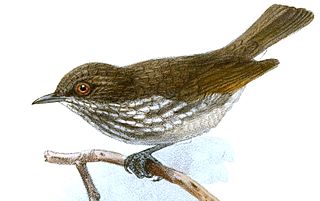
The eastern bearded greenbul is a species of songbird in the bulbul family, Pycnonotidae. It is found from south-eastern Nigeria to Central African Republic, north-eastern Democratic Republic of the Congo, Congo and extreme north-western Angola. Its natural habitats are subtropical or tropical moist lowland forests and subtropical or tropical moist montane forests.

The Philippine bulbul is a songbird species in the bulbul family, Pycnonotidae.

The Zamboanga bulbul is a songbird species in the bulbul family, Pycnonotidae. It is endemic to the Philippines, where its natural habitat is tropical moist lowland forests of Basilan and the Zamboanga Peninsula. It is becoming rare due to habitat loss.

The streak-breasted bulbul is a songbird species in the bulbul family, Pycnonotidae.

The white-throated greenbul, or white-throated bulbul, is a species of songbird in the bulbul family, Pycnonotidae. It is found in many parts of central and western Africa. Its natural habitats are subtropical or tropical moist lowland forests and subtropical or tropical moist montane forests.

The Mindanao white-eye, also known as the black-masked white-eye, is a species of bird in the family Zosteropidae. The specific epithet honours British zoological collector Walter Goodfellow. It is endemic to the Philippines. Its natural habitat is subtropical or tropical moist montane forest.

The brown tit-babbler is a species of bird in the family Timaliidae. It is endemic to the Philippines. Its natural habitats are tropical moist lowland forest and or tropical moist montane forest.

The Philippine jungle flycatcher is a species of passerine bird in the Old World flycatcher family Muscicapidae. It is endemic to the Philippines. Its natural habitat is tropical moist lowland forests up to 1,000 meters above sea level.

The rusty-crowned babbler is a species of bird in the family Zosteropidae. It is native to the southern Philippines on the islands of Mindanao and Dinagat Islands and Basilan. Its natural habitat is tropical moist lowland forest.

The Visayan babbler also known as the Visayan Black-crowned Babbler. is a species of bird in the family Zosteropidae. It is endemic to the Philippines. It is found on Samar, Leyte and Bohol. Its natural habitat is tropical moist lowland forest. It was formerly conspecific to the northern population of the Calabarzon black-crowned babbler but has since been split as a species due to differences in its yellowish throat and whiter belly.

The Mindanao pygmy babbler is a bird species endemic to the Philippines. It had been placed in the family Timaliidae, but it is a close relative of the white-eyes, however, and many taxonomists now place it in the family Zosteropidae..

The Visayan pygmy babbler is a bird species endemic to the Philippines on the islands of Leyte and Samar. It was conspecific with the Mindanao pygmy babbler under the common name of "pygmy babbler".Its natural habitats are tropical moist lowland forests and or tropical moist montane forests.

The ashy-fronted bulbul is a member of the bulbul family of passerine birds. It is endemic to Palawan in the Philippines. Its natural habitat is tropical moist lowland forests. Until 2010, the ashy-fronted bulbul was considered as a subspecies of the olive-winged bulbul.

The Palawan bulbul or grey-throated bulbul is a species of songbird in the family Pycnonotidae. It is endemic to Palawan Island in the Philippines. Its natural habitats are tropical moist lowland forests and tropical moist montane forests.
The Mindoro bulbul is a songbird species in the bulbul family, Pycnonotidae.

The Negros scops owl, also known as the Visayan scops owl, is an owl, endemic to the islands of Negros and Panay in the Philippines, belonging to the family of the typical owls Strigidae. It was formerly classified as a subspecies of the Philippine scops owl. It is threatened by habitat loss and hunting for the pet trade.

The Cebu boobook or Cebu hawk-owl is a species of owl in the family Strigidae. It is endemic to the Philippines. It was formerly considered a subspecies of the Philippine hawk-owl, but was reclassified in 2012, as voice and other data suggested placement in a distinct species.

The Visayan rhabdornis is a species of bird currently placed in the starling family, Sturnidae. It is endemic to the central Philippines on the islands of Negros and Panay. It was previously considered a subspecies of the stripe-breasted rhabdornis. It lives in tropical moist montane forest and is threatened by habitat loss.
The Cebu bulbul also known as the Cebu slaty-crowned bulbul or the Cebu streak-breasted bulbul is a subspecies of the streak-breasted bulbul. It is endemic to the Philippines found only on the island of Cebu where its natural habitat is tropical moist lowland forest. Thought extinct until its rediscovery in 1996, it is threatened by habitat loss and hunting. It is likely that this will eventually be split into a separate species and if so will become one of the most endangered species in the world.

The Calabarzon babbler is a species of bird in the family Zosteropidae. It is endemic to the Philippines. It is only found in Central and Southern Luzon and Catanduanes. Its natural habitat is tropical moist lowland forest. It previously was considered a subspecies of the black-crowned babbler. It is differentiated from its southern counterpart by having a more intense orange chin and olive-toned upper parts.


















